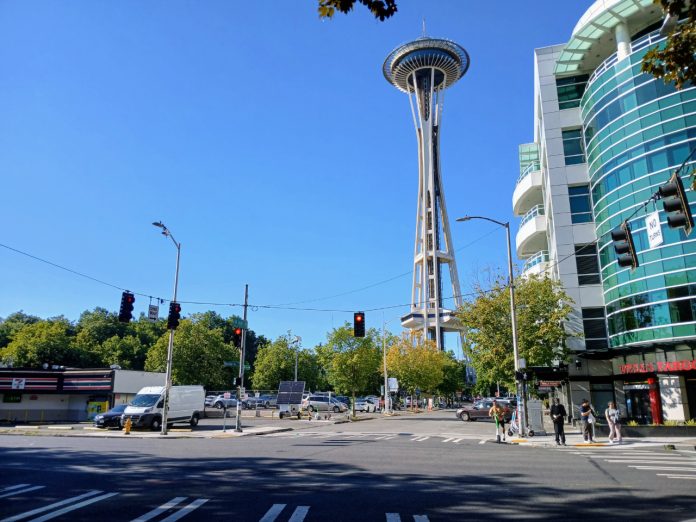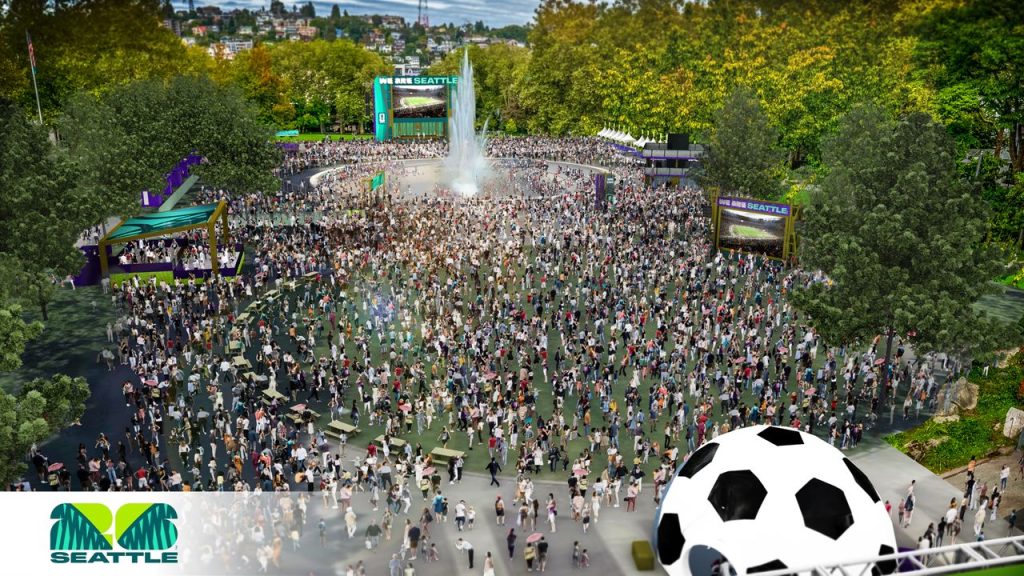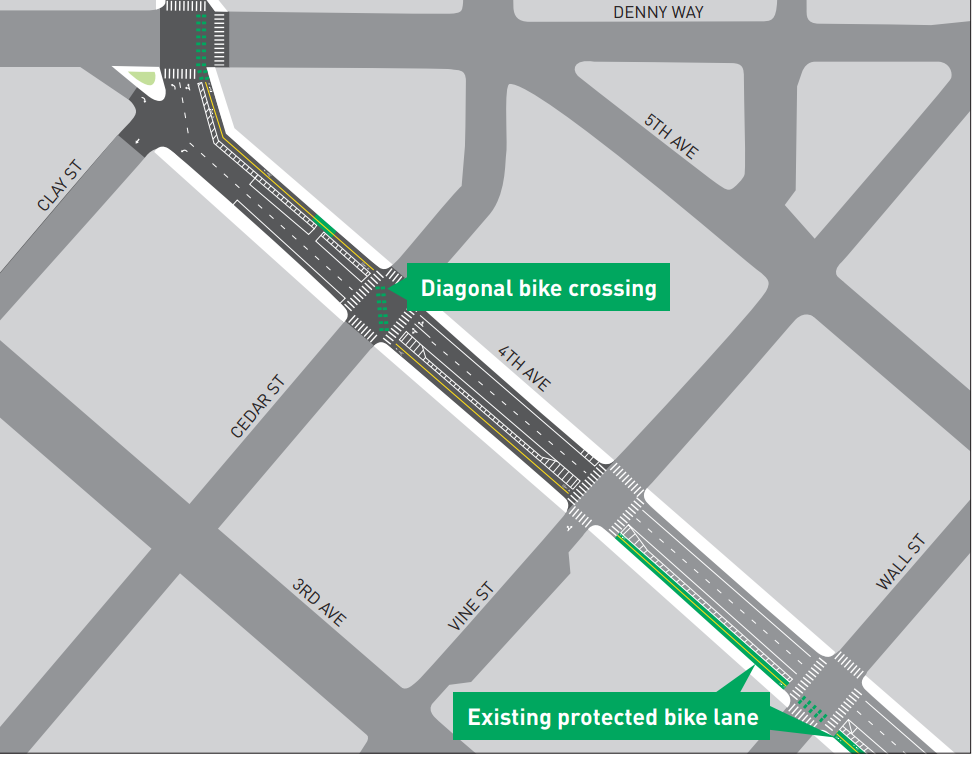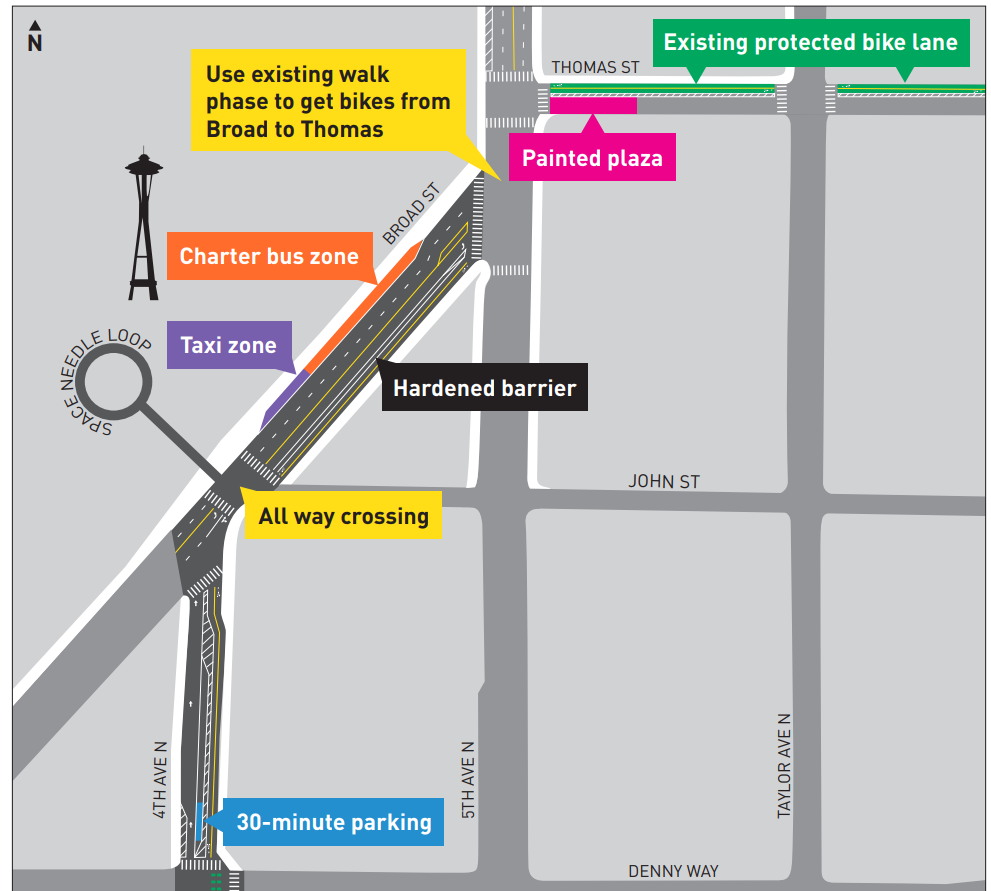
The Seattle Department of Transportation (SDOT) has announced a plan to bridge a gap in the city’s bike lane network between Seattle Center and the rest of downtown, extending the Fourth Avenue protected bike lane north and on through Broad Street to connect with Thomas Street. The impetus for the project: the 2026 FIFA Men’s World Cup and the fan zone planned on the Seattle Center campus, but the permanent infrastructure will stay in place long after visiting soccer fans have left the city.
When complete, the new facility will complete a loop between Thomas Street, the main east-west connection to Seattle Center through South Lake Union, and the highly used Fourth Avenue protected bike lane. In contrast with the other major bike corridor on Second Avenue, which skirts around the Seattle Center campus, this project will directly connect riders with its front door.

SDOT is citing a goal of encouraging 80% of future FIFA match attendees to arrive at their events without a private vehicle as a major goal of extending this connection. But when it comes to permanent infrastructure upgrades on Seattle streets intended to improve mobility ahead of FIFA events, it’s a bit of an outlier.
While next summer’s soccer matches are being treated a major deadline to complete projects already in progress around the region — with Sound Transit’s 2 Line light rail connection across Lake Washington at the top of the list — new ones are harder to come by. While King County Metro is preparing to add a shuttle bus for attendees between the stadiums, central downtown, and the waterfront, the city doesn’t plan any additional bus lanes to complement them, nor additional protected bike lanes around south downtown. An improvement that would have decreased bus delays along the Third Avenue bus mall was officially put on ice after initially planned to coincide with FIFA.
Unlike normal high-demand events at Lumen Field, the six FIFA matches will include additional security measures that translate to less on-site parking directly at the stadium, increasing the necessity to provide additional multimodal options.
Seattle Center’s fan zone is set to be a major destination for the 750,000 Seattle visitors expected for FIFA events. The fan zone is one of 10 planned in different cities across the state. Lumen Field itself can only accommodate 69,000 spectators, so the Seattle Center campus will essentially act as the overflow zone, with a new state law around alcohol access making it much easier to turn the entire area into a beer garden.

Seattle Center’s new connection is set to include one additional block of two-way bike lane along the west side of Fourth Avenue between Vine Street and Cedar Street, before a diagonal crossing to the east side of the street north of Cedar. These diagonal crossings, common across the broader bike network, have proven pretty unpopular with bike riders, with long light cycles usually needed to get riders from one side of the street to the other.
At Denny Way, right turns across the bike lane will be banned, with drivers directed to use Cedar Street to access eastbound Denny Way instead.

On the other side of Denny, the two-way bike lane will replace of a row of back-angle parking alongside Fisher Plaza, continuing up to Broad Street. There it will navigate the trickiest intersection along the stretch, at the loop driveway at the Space Needle leading to the valet parking area. At this intersection, SDOT proposes a new all-way crossing cycle fully separating walkers and rollers from drivers, but as one of the busiest pedestrian crossings in the city, implementing this will make or break the project.

Finally, at Thomas Street riders will use the existing walk cycle to either head eastbound toward South Lake Union or west into Seattle Center. This project coincides with Seattle’s Center’s plans to revitalize the Thomas Street pedestrian corridor to “improve the streetscape, strengthen the connection to surrounding neighborhoods, and create a welcoming and exciting experience for visitors.” As the major way for people walking and biking to connect directly through the civic campus to get to Uptown, that change could be a significant improvement, if done right.
With this connection built, it should turn an additional connection on Fifth Avenue N into a layup: there are even a few hundred feet of protected bike lane on that street already. But the major renovation of Memorial Stadium, a joint venture of the City of Seattle, Seattle Public Schools, and the private One Roof Foundation, is set to leave the expanse of surface parking along Fifth fully intact and the bike network disconnected.
The Belltown to Seattle Center Connection Project is still in early design, with construction set to be fully completed by next summer’s six world cup matches.
Ryan Packer has been writing for The Urbanist since 2015, and currently reports full-time as Contributing Editor. Their beats are transportation, land use, public space, traffic safety, and obscure community meetings. Packer has also reported for other regional outlets including BikePortland, Seattle Met, and PubliCola. They live in the Capitol Hill neighborhood of Seattle.

